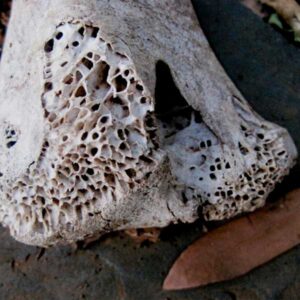I regularly avail myself of the short videos available on Dr. Michael Greger’s website nutritionfacts.org. His group of researchers scour and vet peer-reviewed scientific journals to present best evidence on a variety of health-related topics. A recent series on osteoporosis caught my attention. Here are high-level findings that I gleaned from it:
 Weak bones do not present issues in the absence of excessive load caused by a fall or heavy lifting. They generally don’t break in the course of normal life activities. Only 15% of bone fractures can be tied to osteoporosis in women. Roughly 40% of hip fractures are due to impaired balance. Not surprisingly, hip fracture risk increases 13-fold between the ages of 60 and 80 when muscle weakness and loss of balance tends to become commonplace.
Weak bones do not present issues in the absence of excessive load caused by a fall or heavy lifting. They generally don’t break in the course of normal life activities. Only 15% of bone fractures can be tied to osteoporosis in women. Roughly 40% of hip fractures are due to impaired balance. Not surprisingly, hip fracture risk increases 13-fold between the ages of 60 and 80 when muscle weakness and loss of balance tends to become commonplace.
The best advice for preventing hip fracture: Don’t fall. Keep things within easy reach; avoid using step stools. Use non-stick mats in the bathroom and add grab bars to showers and toilet areas. Keep floors clutter free. Get rid of decorative throw rugs. Use hand rails when going up and down stairs. Don’t walk outdoors during inclement weather.
Balance and strength training reduces the risk of falls by 34% and cuts fracture rates by half. They combat age-related risk factors for falls. Moreover, weight-bearing exercise and impact training at moderate-to-high intensity encourages bone growth when pursued consistently. Want a simple bone-building exercise to add to the daily regimen? Hop up and down on each foot 50 times!
Dr. Gregor recommends 9 servings of fruit and vegetables daily. They decrease inflammation and oxidation and promote a healthy acid-base balance in the blood stream. (The body leaches calcium from bones when the blood gets too acidic.) Foods that are especially good for bone health include prunes, onions, leeks, garlic, cruciferous vegetables, and tomatoes.
Stop smoking. It’s bad for the bones and bad for health overall. Enough said.
Even though they are routinely recommended by general practitioners, calcium supplements may not be beneficial. To be sure, the body needs a steady supply of calcium to support bone growth and other metabolic functions. However, supplementation may cause unhealthy calcium spikes in the bloodstream. Dr. Greger cited a study in which 1,000 people used calcium supplements for 5 years. While their usage prevented 26 fractures, participants reported 14 heart attacks, 10 strokes, and 13 deaths that were attributed to calcium supplementation.
Dr. Gregor invites us to get the recommended daily dose of calcium through the diet. Food presents calcium in combination with other substances that aid in absorption while spreading the required amounts throughout the day. Put dark leafy greens such as kale, collard greens, and Bok choy on the menu. Avoid milk due to the presence of galactose (sugar) which causes bone loss due to oxidative stress and inflammation. In fact, studies show that hip fracture rates correlate positively with milk consumption. If a fan of daily, switch to yogurt or cheese; the fermentation process reduces sugar.
Vitamin D supplementation appears to support healthy bones when taken in amounts between 1600-3200 daily. Vitamin D increases calcium absorption in the intestines and stimulates the kidneys to reabsorb calcium from urine. Supplementation more than 4000 IU daily has been associated with higher fall risk.
Dr. Greger takes a dim view of pharmaceutical intervention, listing the most popular medication (Fosamax) by name. Fosamax disrupts normal bone remodeling by killing off osteoclasts (a.k.a. the bone demolition team) and thereby diminishing osteoblast activity (a.k.a. the bone building team). Physicians typically prescribe this medication when osteoclasts outpace osteoclasts, resulting in sustained bone loss year by year. Clinical trials showed that it cut the 5-year hip fracture rate by half. Dr. Gregor argues for a natural approach to reducing fracture risk while avoiding complications associated with disrupting the body’s normal bone remodeling processes.